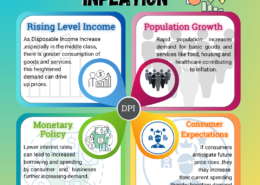Analyze how the agriculture sector affects inflationary pressures, especially when it comes to food price volatility, and evaluate the government’s initiatives to raise agricultural production, streamline the supply chain, and keep food prices stable.
Government's Use of Fiscal Policy Tools to Address Inflationary Impact The government employs various fiscal policy tools, such as reducing excise duties on fuel and providing subsidies, to mitigate the inflationary effects of increasing global commodity prices. Reduction of Excise Duties on Fuel: ORead more
Government’s Use of Fiscal Policy Tools to Address Inflationary Impact
The government employs various fiscal policy tools, such as reducing excise duties on fuel and providing subsidies, to mitigate the inflationary effects of increasing global commodity prices.
Reduction of Excise Duties on Fuel:
One of the key measures adopted by the government to counter the inflationary impact of rising global commodity prices is the reduction of excise duties on fuel. Lowering excise duties on petrol and diesel can help in curbing the direct impact of high fuel prices on inflation, as fuel costs affect transportation and production costs across various sectors.
Provision of Subsidies:
Additionally, the government provides subsidies in various forms to stabilize prices and shield consumers from the full impact of rising commodity prices. Subsidies on essential commodities like food items can help in controlling inflation by keeping prices in check for consumers.
Assessment of Sustainability and Efficacy
Sustainability of Measures:
While reductions in excise duties and the provision of subsidies can provide short-term relief from inflationary pressures, their sustainability over the long term can be challenging. Heavy reliance on subsidies can strain government finances and may not be a sustainable solution in the face of prolonged commodity price hikes.
Efficacy of Measures:
The efficacy of these fiscal policy tools in addressing inflationary impacts depends on various factors. While reducing excise duties on fuel can help in easing immediate price pressures, the extent to which these reductions are passed on to consumers by oil marketing companies also plays a crucial role in determining their effectiveness.
Recent Examples:
In recent years, the Indian government has utilized these fiscal policy tools to address the inflationary impact of rising global commodity prices. For instance, during periods of sharp increases in fuel prices, the government has occasionally announced excise duty cuts to provide relief to consumers. Similarly, subsidies on essential commodities have been used to stabilize prices and protect vulnerable sections of society from the impact of inflation.
Conclusion:
In conclusion, while the government’s use of fiscal policy tools like reducing excise duties on fuel and providing subsidies can be effective in managing inflationary pressures in the short term, their sustainability and long-term efficacy need to be carefully evaluated. A balanced approach that considers the broader economic implications and fiscal sustainability is essential to ensure that these measures effectively mitigate the impact of rising global commodity prices on inflation while supporting overall economic stability.


The agricultural sector plays a significant role in contributing to inflationary pressures, particularly through the volatility in food prices. Several factors contribute to this dynamic: Supply-side shocks: Agricultural production can be highly susceptible to factors such as weather patterns, pestsRead more
The agricultural sector plays a significant role in contributing to inflationary pressures, particularly through the volatility in food prices. Several factors contribute to this dynamic:
Recognizing these challenges, governments have implemented various initiatives to enhance agricultural productivity, improve supply chain efficiency, and stabilize food prices:
The impact of these government initiatives has been mixed. While some interventions have helped to increase agricultural productivity and stabilize food prices, the effectiveness has often been limited by factors such as resource constraints, political considerations, and the complexity of global food systems.
Moreover, the COVID-19 pandemic and geopolitical tensions, such as the Russia-Ukraine conflict, have further exacerbated the challenges facing the agricultural sector, underscoring the need for comprehensive, coordinated, and adaptive approaches to address food price inflation and ensure food security.
Going forward, a holistic approach that combines supply-side, demand-side, and market-based interventions, along with strengthened international cooperation, will be crucial in enhancing the agricultural sector’s resilience and its role in mitigating inflationary pressures.
See less